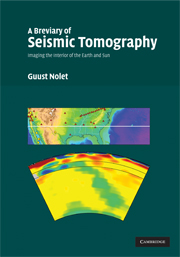Book contents
- Frontmatter
- Contents
- Preface
- 1 Introduction
- 2 Ray theory for seismic waves
- 3 Ray tracing
- 4 Wave scattering
- 5 Body wave amplitudes: theory
- 6 Travel times: observations
- 7 Travel times: interpretation
- 8 Body wave amplitudes: observation and interpretation
- 9 Normal modes
- 10 Surface wave interpretation: ray theory
- 11 Surface waves: finite-frequency theory
- 12 Model parametrization
- 13 Common corrections
- 14 Linear inversion
- 15 Resolution and error analysis
- 16 Anisotropy
- 17 Future directions
- References
- Author index
- General index
8 - Body wave amplitudes: observation and interpretation
Published online by Cambridge University Press: 24 January 2011
- Frontmatter
- Contents
- Preface
- 1 Introduction
- 2 Ray theory for seismic waves
- 3 Ray tracing
- 4 Wave scattering
- 5 Body wave amplitudes: theory
- 6 Travel times: observations
- 7 Travel times: interpretation
- 8 Body wave amplitudes: observation and interpretation
- 9 Normal modes
- 10 Surface wave interpretation: ray theory
- 11 Surface waves: finite-frequency theory
- 12 Model parametrization
- 13 Common corrections
- 14 Linear inversion
- 15 Resolution and error analysis
- 16 Anisotropy
- 17 Future directions
- References
- Author index
- General index
Summary
Body wave amplitudes are influenced by three factors: the loss of energy by attenuative effects, the focusing or defocusing of rays and the local impedance (the product of density and velocity). The effect of perturbations in density or impedance can easily influence the amplitude of a wave, but it is essentially a local effect, independent of the larger-scale structure of the Earth, and we shall treat impedance variations with the method of corrections detailed in Chapter 13. Here we concentrate on focusing and attenuation.
In contrast to the numerous studies of delay times, body wave amplitude studies are rare. Early regional studies, resulting in 1D models for the attenuation beneath a particular province, were done by Solomon and Toksöz, Jordan and Sipkin and Lay and Helmberger. Such studies made use of the fact that the low–Q asthenosphere below the source and receiver causes a major part of the body wave attenuation. Since teleseismic rays in the upper mantle travel close to the vertical, differences in amplitude observed at stations for the same event can be attributed to differences in the strength and/or thickness of the asthenosphere approximately beneath the station. This allows us to see strong differences in attenuation between different regions. Though studies of this kind continue to provide insight (e.g. Warren and Shearer), this method is not really tomographic. Sanders et al. and Ho-Liu et al. were the first to apply the methods of tomography to attenuation data.
- Type
- Chapter
- Information
- A Breviary of Seismic TomographyImaging the Interior of the Earth and Sun, pp. 145 - 157Publisher: Cambridge University PressPrint publication year: 2008



